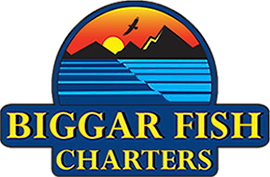BC Area Fish: Chinook and Coho Salmon
Natural Range
The Chinook Salmon (Oncorhynchus tshawytscha) is the largest species of salmon found in the North Pacific Ocean and the river systems of western North America, ranging from California to Alaska, as well as rivers ranging from northern Japan to North-East Siberia. Other common names include King salmon (USA), Quinnat salmon (New Zealand), Spring salmon and Tyee salmon (30 lbs. or larger).
Coho salmon (Oncorhynchus kisutch), also known as Silver salmon (USA) range on both sides of the North Pacific Ocean, the same as Chinook salmon.
Introduced Populations
Chinook salmon were introduced to Lake Michigan and Lake Huron in 1967 to control the alewife, an invasive species of fish from the Atlantic Ocean. With the introduction of both Chinook and Coho salmon (a year earlier) the program was a success and Chinook and Coho salmon were planted into the rest of the Great Lakes where sport fishermen now prize them. Coho salmon have also been introduced to many landlocked reservoirs throughout the USA.
In South America escaped Chinook hatchery fish have established stable spawning runs in Patagonian waters and have been found in the upper Rio Santa Cruz over 620 miles from the ocean. New Zealand was successful in the early 1900s in importing and establishing spawning runs of Chinook salmon in seven different river systems.
Description
Chinook salmon have silvery sides with black speckles on a dark, bronze back. Black spots are found all over their tail (upper and lower lobes) and they have a black gum line. On average adult fish range between 24”-36” but can be up to 58” in length. Although Chinook generally average between 10-50 lbs. in size they can reach 130 lbs. The current sport-caught record caught on May 17, 1985 in the Kenai River, Alaska is 97 lbs. 4 oz. The commercial catch world record is 126 lbs. caught near Rivers Inlet, British Columbia in the late 1970’s.
Coho salmon have silver sides with black spots on a metallic blue back. Black spots are found only on the top (upper lobe) of their tail and have white gums. Mature adults average between 5-11 lbs. with the current sport-caught record weighing in at 33 lbs. 4 oz. caught in the Salmon River, New York on September 27th, 1989.
Lifecycle
Chinook salmon will spend between one to eight years in the ocean before returning to their home river to spawn although the average is about three to four years while Coho salmon spend only one to three years in ocean life. Chinook leave the ocean and enter freshwater between mid-summer and late fall to begin the final migration to their spawning beds found in larger and deeper rivers while Coho enter freshwater in the fall to return to small short streams.
After a female Chinook salmon lays between 4,000-6,000 eggs in the gravel bed to be fertilized by the male(s), she will guard her nest (redd) for 4-25 days before dying, while the males keep searching for more mates until they ultimately die as well. Female Coho will lay between 2,500-5,000 eggs in quite small shallow streams.
The incubation period is between 3-5 months, depending on water temperature. Once the salmon eggs hatch the fry (young fish) will stay in fresh water for 12 or more months for Chinook and 12-24 months for Coho before they depart downstream to the estuary. Estuaries are extremely important nursery areas over the next several months for both the Chinook and Coho (smolts), as a greater variety of food sources can be found there than in freshwater and it is here in the brackish (low salinity) waters they’ll be able to adapt to ocean salinity.
After several months they’ll begin their northward migration with estimates of about 6-9 miles per day of travel. During the adult stage of their life Chinook salmon will feed primarily on Krill (shrimplike crustaceans), Herring, Anchovies, Needlefish, Squid and Sandlance. Coho will feed on Herring, Sandlance, Crustaceans and jellyfish.
After a few years their hormonal development will compel them to begin their journey back to their birthplace to spawn from as far north as the Bering Sea and Gulf of Alaska. Feeding continues on their migration route right up until they enter freshwater. Thereafter both species will depend on their fat reserves for energy to reach their spawning beds with the longest freshwater migration route for Chinook being the Yukon River from the Bering Sea to Whitehorse, Yukon, a distance of 1,900 miles.
During all stages of both Chinook and Coho salmon development, from egg to adult, the mortality of these fish can sometimes be 95% or more, hence the need for millions of eggs in the spawning process to maintain a viable spawning population. Wild Coho salmon stocks are far more susceptible to habitat destruction by man and rely upon man’s intervention with fish hatcheries to ensure their survival.
Nutritional Value
Both ocean-caught Chinook and Coho salmon are regarded as excellent table fare. Chinook and Sockeye salmon have the highest fat content in their meat of all salmon and are an excellent source of Omega-3 fatty acids. Due to the higher fat content of Chinook, “hot-smoking” is best for this salmon while Coho salmon with a moderate to high amount of fat are best suited for “cold-smoking” (lox).

